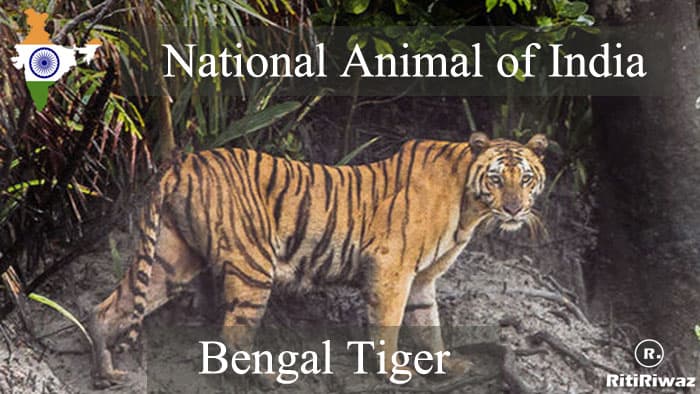National Animal of India | Indian National Animal

The Tiger – Lord of the Indian Jungles, is the National Animal of India. The tiger is the symbol of India’s wealth of wildlife. The Royal Bengal Tiger is a subspecies of tigers primarily found in Bangladesh and India and also in Nepal, Bhutan, Myanmar, and southern Tibet.
It is the most common tiger subspecies, and lives in a variety of habitats, including grasslands, subtropical and tropical rainforests, scrub forests, wet and dry deciduous forests, and mangroves. Its fur is orange-brown with black stripes, although there is a mutation that sometimes produces white tigers. It is the national animal of both Bangladesh and India.
The magnificent Tiger Panthera tigris (Linnaeus), the Indian national animal, is a rich-colored well-striped animal with a short coat. The combination of grace, strength, power has earned the tiger great respect and high esteem. Indian tigers are famous all over the world and one of the main attractions for lovers of wildlife. They are the crowning glory and the light of Indian wildlife.
Tough, muscular, majestic tigers roam about the Sunderbans of Bengal “burning brightly in the darkness of the night.” The natives of the forest worship the tiger as the deity that gives them honey and wax. The Sunderbans are their main habitat for their thick forests of Sunder trees. They feed on fish, cattle, and sometimes human beings. The man-eaters are the most dreaded of all wild beasts. It is a common belief that a tiger does not harm anyone who has offered prayers to him. Tigers are fast runners, excellent swimmers and their eyesight are strong.
Suggested Read: National Fruit Of India
To check the dwindling population of tigers in India, which came down to just 1,827 in 1972, a massive conservation program was initiated in April 1973, known as the ‘Project Tiger’. This project aims to maintain a viable population of tigers in India for scientific, economic, aesthetic, cultural, and ecological values. Since then, the tiger population has shown a gradual increase and the census of 1989 puts the tiger population of the country at 4,334. So far, 19 tiger reserves have been established in the country under this project, covering over 29, 716 sq. km. forest area.
Male Bengal Tigers measure around 6 to 9 feet in length (without their tail), and 9 to 12 feet with their tail. Their weight is around 400 to 660 pounds (180 to 300 kilograms). A Bengal Tiger normally stands at around 3 feet (0.97 m) at the shoulder. They have a maximum skull length of around 10 to 15 inches (250 to 380 mm). An average male Bengal Tiger living in southern and central India weighs in at about 500 pounds (230 kg), stands 3 feet tall, and stretches about 10 feet (2.9 m) in length (head to tail).
However, the Tigers found in the northern Indian subcontinent are notably larger, with many instances of tigers over 300 kg and up to 13 feet in length (head to tail). The largest Bengal ever recorded was shot in Northern India in 1967, 3.35 mt in total length, and weighed 388 kg, (857 lbs), while two others, killed in Nepal in 1942, and in India in 1910, weighed 320 kg and 317 kg, respectively. Jim Corbett also once shot a tiger called the Bachelor of Powalgarh, with a total length of 3.23m, thought to be “as big as a Shetland pony” by the famous hunter Fred Anderson. Pictures of this cat documented that it was indeed a very large tiger.
Female Bengal Tigers measure around 5 to 6 feet in length (without their tail), and 7 to 9, with their tail. They weigh around 250 to 450 pounds (110 to 200 kg). They stand about 2 feet (75 cm) tall at the shoulder. They have a maximum skull length of about 8 to 12 inches long. An average female Bengal Tiger living in the wild will weigh about 300-350 pounds (140-160 kg), stand 2 feet (0.8 m) tall, and stretch about 8 feet (2.4 m) in length head to tail.
Suggested Read: National Symbols Of India






